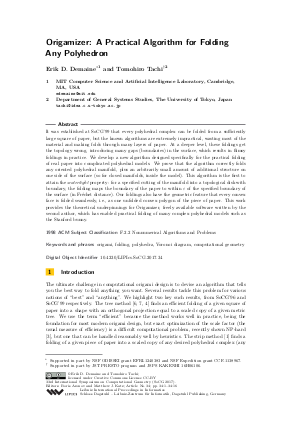Origamizer: A Practical Algorithm for Folding Any Polyhedron
Authors Erik D. Demaine, Tomohiro Tachi
-
Part of:
Volume:
33rd International Symposium on Computational Geometry (SoCG 2017)
Part of: Series: Leibniz International Proceedings in Informatics (LIPIcs)
Part of: Conference: Symposium on Computational Geometry (SoCG) - License:
 Creative Commons Attribution 3.0 Unported license
Creative Commons Attribution 3.0 Unported license
- Publication Date: 2017-06-20
File

PDF
LIPIcs.SoCG.2017.34.pdf
- Filesize: 8.03 MB
- 16 pages
Document Identifiers
Subject Classification
Keywords
- origami
- folding
- polyhedra
- Voronoi diagram
- computational geometry
Metrics
- Access Statistics
-
Total Accesses (updated on a weekly basis)
0Document
0Metadata
Abstract
It was established at SoCG'99 that every polyhedral complex can be folded from a sufficiently large square of paper, but the known algorithms are extremely impractical, wasting most of the material and making folds through many layers of paper. At a deeper level, these foldings get the topology wrong, introducing many gaps (boundaries) in the surface, which results in flimsy foldings in practice. We develop a new algorithm designed specifically for the practical folding of real paper into complicated polyhedral models. We prove that the algorithm correctly folds any oriented polyhedral manifold, plus an arbitrarily small amount of additional structure on one side of the surface (so for closed manifolds, inside the model). This algorithm is the first to attain the watertight property: for a specified cutting of the manifold into a topological disk with boundary, the folding maps the boundary of the paper to within epsilon of the specified boundary of the surface (in Fréchet distance). Our foldings also have the geometric feature that every convex face is folded seamlessly, i.e., as one unfolded convex polygon of the piece of paper. This work provides the theoretical underpinnings for Origamizer, freely available software written by the second author, which has enabled practical folding of many complex polyhedral models such as the Stanford bunny.
Cite As Get BibTex
Erik D. Demaine and Tomohiro Tachi. Origamizer: A Practical Algorithm for Folding Any Polyhedron. In 33rd International Symposium on Computational Geometry (SoCG 2017). Leibniz International Proceedings in Informatics (LIPIcs), Volume 77, pp. 34:1-34:16, Schloss Dagstuhl – Leibniz-Zentrum für Informatik (2017)
https://doi.org/10.4230/LIPIcs.SoCG.2017.34
BibTex
@InProceedings{demaine_et_al:LIPIcs.SoCG.2017.34,
author = {Demaine, Erik D. and Tachi, Tomohiro},
title = {{Origamizer: A Practical Algorithm for Folding Any Polyhedron}},
booktitle = {33rd International Symposium on Computational Geometry (SoCG 2017)},
pages = {34:1--34:16},
series = {Leibniz International Proceedings in Informatics (LIPIcs)},
ISBN = {978-3-95977-038-5},
ISSN = {1868-8969},
year = {2017},
volume = {77},
editor = {Aronov, Boris and Katz, Matthew J.},
publisher = {Schloss Dagstuhl -- Leibniz-Zentrum f{\"u}r Informatik},
address = {Dagstuhl, Germany},
URL = {https://drops.dagstuhl.de/entities/document/10.4230/LIPIcs.SoCG.2017.34},
URN = {urn:nbn:de:0030-drops-72315},
doi = {10.4230/LIPIcs.SoCG.2017.34},
annote = {Keywords: origami, folding, polyhedra, Voronoi diagram, computational geometry}
}
Author Details
References
-
Erik D. Demaine, Martin L. Demaine, and Joseph S. B. Mitchell. Folding flat silhouettes and wrapping polyhedral packages: New results in computational origami. Computational Geometry: Theory and Applications, 16(1):3-21, 2000.

-
Erik D. Demaine, David Eppstein, Jeff Erickson, George W. Hart, and Joseph O'Rourke. Vertex-unfolding of simplicial manifolds. In Discrete Geometry: In Honor of W. Kuperberg’s 60th Birthday, pages 215-228. Marcer Dekker Inc., 2003.

-
Erik D. Demaine, Sándor P. Fekete, and Robert J. Lang. Circle packing for origami design is hard. In Origami⁵: Proceedings of the 5th International Conference on Origami in Science, Mathematics and Education, pages 609-626. A K Peters, Singapore, July 2010.

-
Erik D. Demaine and Joseph O'Rourke. Geometric Folding Algorithms: Linkages, Origami, Polyhedra. Cambridge University Press, July 2007.

- Erik D. Demaine and Tomohiro Tachi. Origamizer: A practical algorithm for folding any polyhedron. Manuscript, 2017. URL: http://erikdemaine.org/papers/Origamizer/.
-
Robert J. Lang. A computational algorithm for origami design. In Proceedings of the 12th Annual ACM Symposium on Computational Geometry, pages 98-105, Philadelphia, PA, May 1996.

-
Robert J. Lang and Erik D. Demaine. Facet ordering and crease assignment in uniaxial bases. In Origami⁴: Proceedings of the 4th International Conference on Origami in Science, Mathematics, and Education, Pasadena, California, September 2006.

- Tomohiro Tachi. Software: Origamizer, 2008. URL: http://www.tsg.ne.jp/TT/software/.
- Tomohiro Tachi. Origamizing polyhedral surfaces. IEEE Transactions on Visualization and Computer Graphics, 16(2):298-311, 2010. URL: http://dx.doi.org/10.1109/TVCG.2009.67.
- W. T. Tutte. How to draw a graph. Proceedings of the London Mathematical Society, 13:743-767, 1963. URL: http://plms.oxfordjournals.org/cgi/pdf_extract/s3-13/1/743, URL: http://dx.doi.org/doi:10.1112/plms/s3-13.1.743.
